Documents: Go to download!
- Owner's manual - (English)
- Operating Instructions
- Care and Cleaning
- Troubleshooting
Table of contents
Owner's Guide Refrigerator
Operating Instructions
About the temperature controls.
Not all features are on all models.

The temperature controls are preset in the factory at 37°F for the refrigerator compartment and 0°F for the freezer compartment. Allow 24 hours for the temperature to stabilize to the preset recommended settings.
The temperature controls can display both the SET temperature as well as the actual temperature in the refrigerator and freezer. The actual temperature may vary slightly from the SET temperature based on usage and operating environment.
Setting either or both controls to OFF stops cooling in both the freezer and refrigerator compartments, but does not shut off electrical power to the refrigerator.
NOTE: The refrigerator is shipped with protective film covering the temperature controls. If this film was not removed during installation, remove it now.
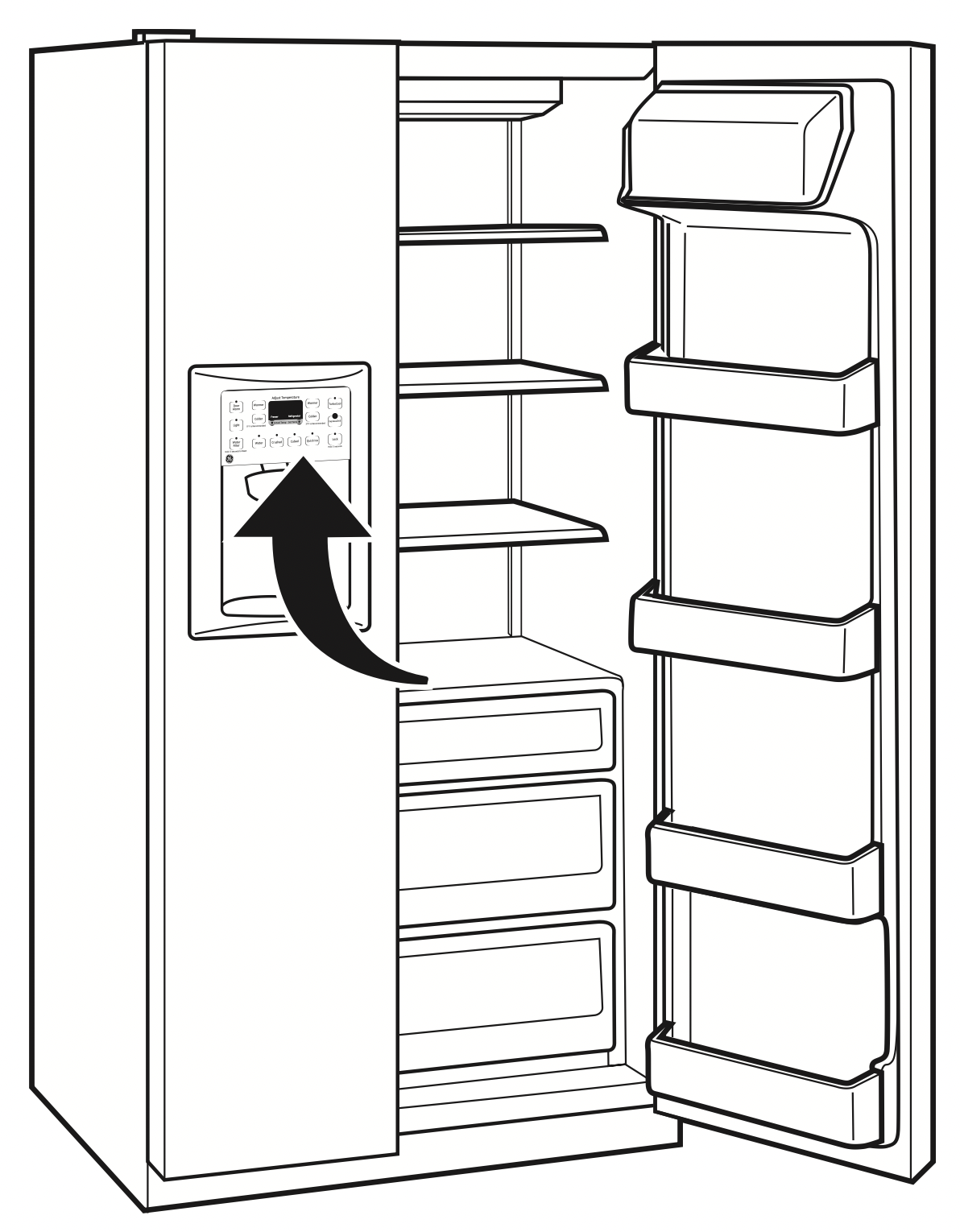
About TurboCool. ™ (on some models)
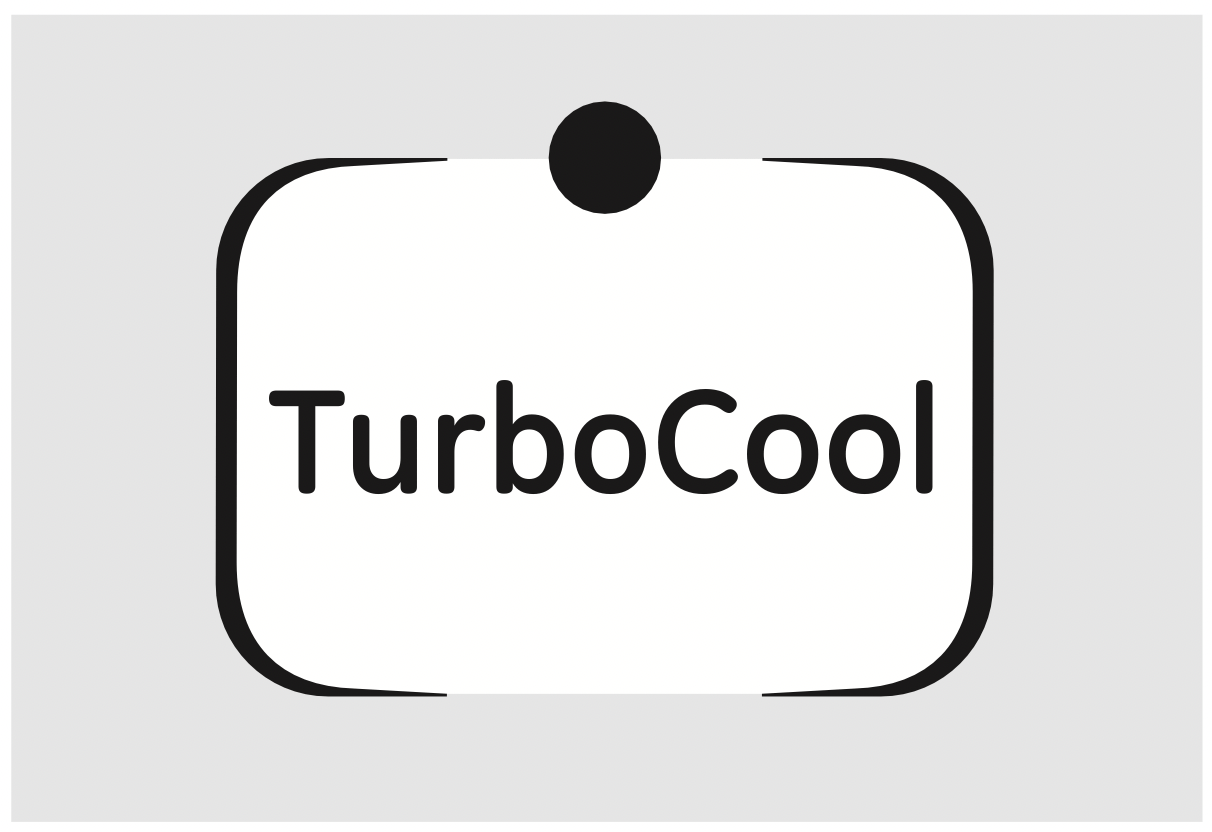
How it Works
TurboCool rapidly cools the refrigerator compartment in order to more quickly cool foods. Use TurboCool when adding a large amount of food to the refrigerator compartment, putting away foods after they have been sitting out at room temperature or when putting away warm leftovers. It can also be used if the refrigerator has been without power for an extended period.
Once activated, the compressor will turn on immediately and the fans will cycle on and off at high speed as needed for eight hours. The compressor will continue to run until the refrigerator compartment cools to approximately 34°F (1°C), then it will cycle on and off to maintain this setting. After 8 hours, or if TurboCool is pressed again, the refrigerator compartment will return to the original setting.
How to Use
Press TurboCool. The refrigerator temperature display will show Tc and the LED will be activated.
After TurboCool is complete, the refrigerator compartment will return to the original setting.
NOTES:
- The refrigerator temperature cannot be changed during TurboCool.
- The freezer temperature is not affected during TurboCool.
- When opening the refrigerator door during TurboCool, the fans will continue to run if they have cycled on.
About the water filter. (on some models)
On some models
Water Filter Cartridge
The water filter cartridge is located in the back upper right corner of the refrigerator compartment.
When to Replace the Filter on Models With a Replacement Indicator Light
There is a replacement indicator light for the water filter cartridge on the dispenser. This light will turn orange to tell you that you need to replace the filter soon.
The filter cartridge should be replaced when the replacement indicator light turns red or if the flow of water to the dispenser or icemaker decreases.
When to Replace the Filter on Models Without a Replacement Indicator Light
The filter cartridge should be replaced every six months or earlier if the flow of water to the water dispenser or icemaker decreases.
Removing the Filter Cartridge
If you are replacing the cartridge, first remove the old one by slowly turning it to the left. Do not pull down on the cartridge. A small amount of water may drip down.
Installing the Filter Cartridge
- If you are replacing a SmartWater cartridge with an adapter, it must be removed before installing the cartridge. To remove the adapter, turn it to the left about 1/4 turn.
If you are replacing a Water by Culligan cartridge, leave the adapter in place. This adapter will stay in the refrigerator when you replace future cartridges.
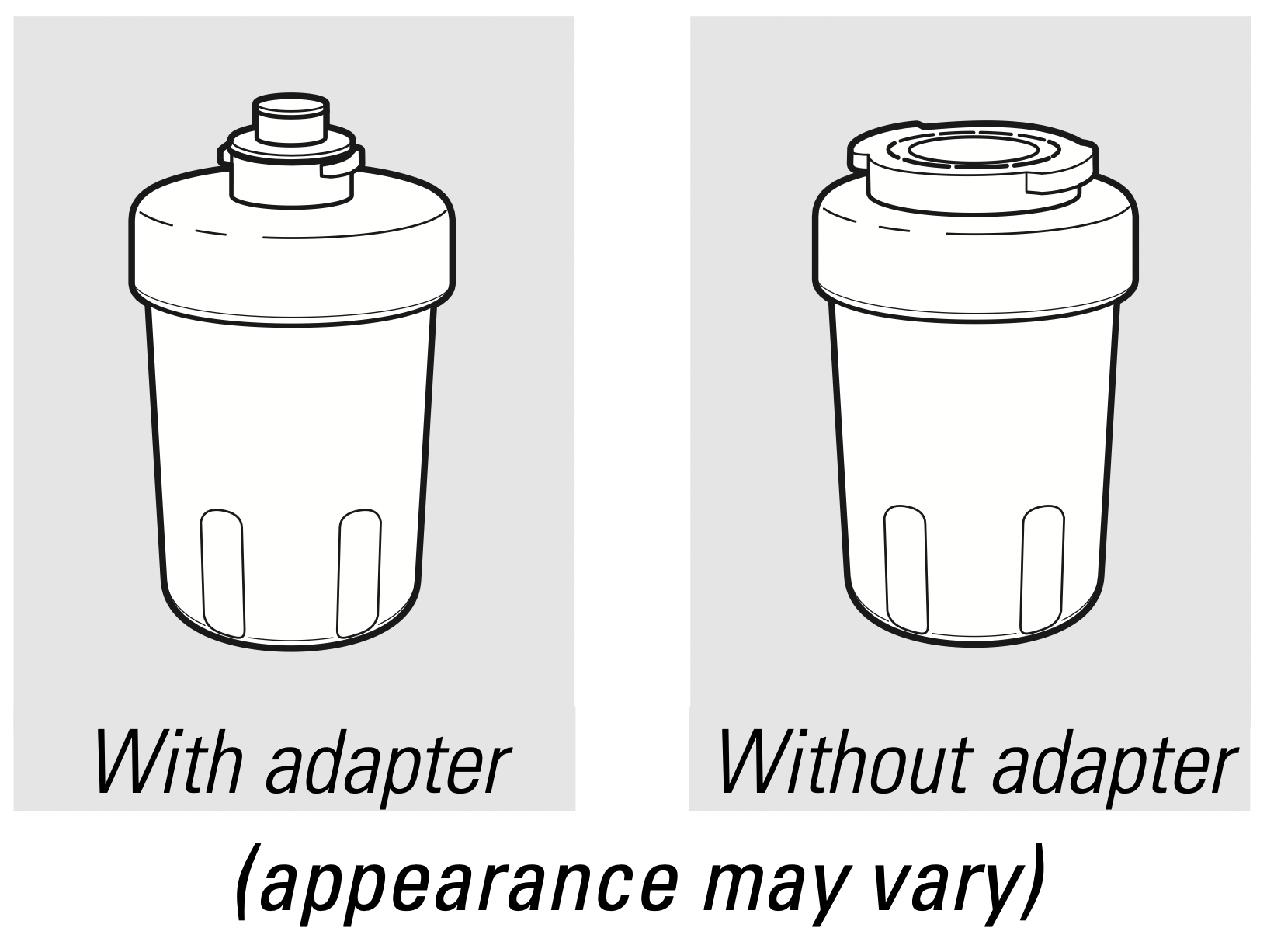
- On models without a replacement indicator light, apply the month and year sticker to the new cartridge to remind you to replace the filter in six months.
- Fill the replacement cartridge with water from the tap to allow for better flow from the dispenser immediately after installation.
- Line up the arrow on the cartridge and the cartridge holder. Place the top of the new cartridge up inside the holder. Do not push it up into the holder.
- Slowly turn it to the right until the filter cartridge stops. DO NOT OVERTIGHTEN. As you turn the cartridge, it will automatically raise itself into position. The cartridge will move about 1/2 turn.

- Run water from the dispenser for 3 minutes (about 1-1/2 gallons) to clear the system and prevent sputtering.
- Press and hold the WATER FILTER pad (on some models) on the dispenser for 3 seconds.

See other models: HTH16BBSXLCC GTH18KBRDRCC ZDP48L6RH2SS GLD3806T05BB GTH18CCEERWW
NOTE: A newly-installed water filter cartridge may cause water to spurt from the dispenser.
Filter Bypass Plug
You must use the filter bypass plug when a replacement filter cartridge is not available. The dispenser and the icemaker will not operate without the filter or filter bypass plug.

To use the filter bypass plug on Water by Culligan models, you must first remove the filter adapter from the cartridge holder by turning it to the left.
About the shelves and bins.
Not all features are on all models.
Refrigerator Door Bins
The refrigerator door bins are adjustable.
To remove: Lift the front of the bin straight up, then lift up and out.
To replace or relocate: Engage the back side of the bin in the molded supports of the door. Then push down on the front of the bin. Bin will lock in place.
The snugger helps prevent tipping, spilling or sliding of small items stored on the door shelf. Place a finger on either side of the snugger near the rear and move it back and forth to fit your needs.
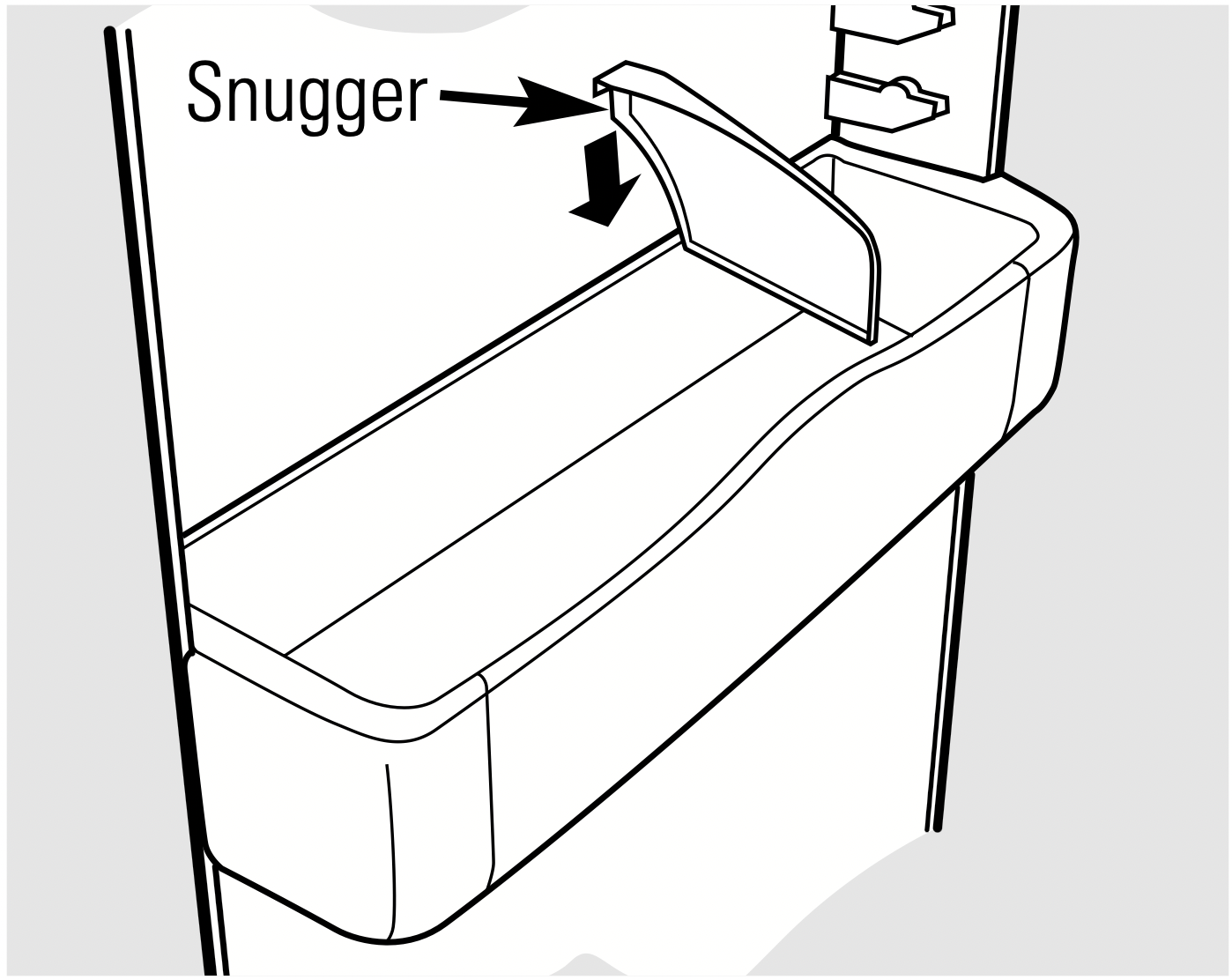
Deep Door Shelves
Detachable shelf extenders deepen and enclose fixed door shelves, providing more storage room and greater storage flexibility.
To remove: Lift the shelf extender straight up then pull out.
To replace: Engage the shelf extender in the molded supports on the door and push in. It will lock in place.
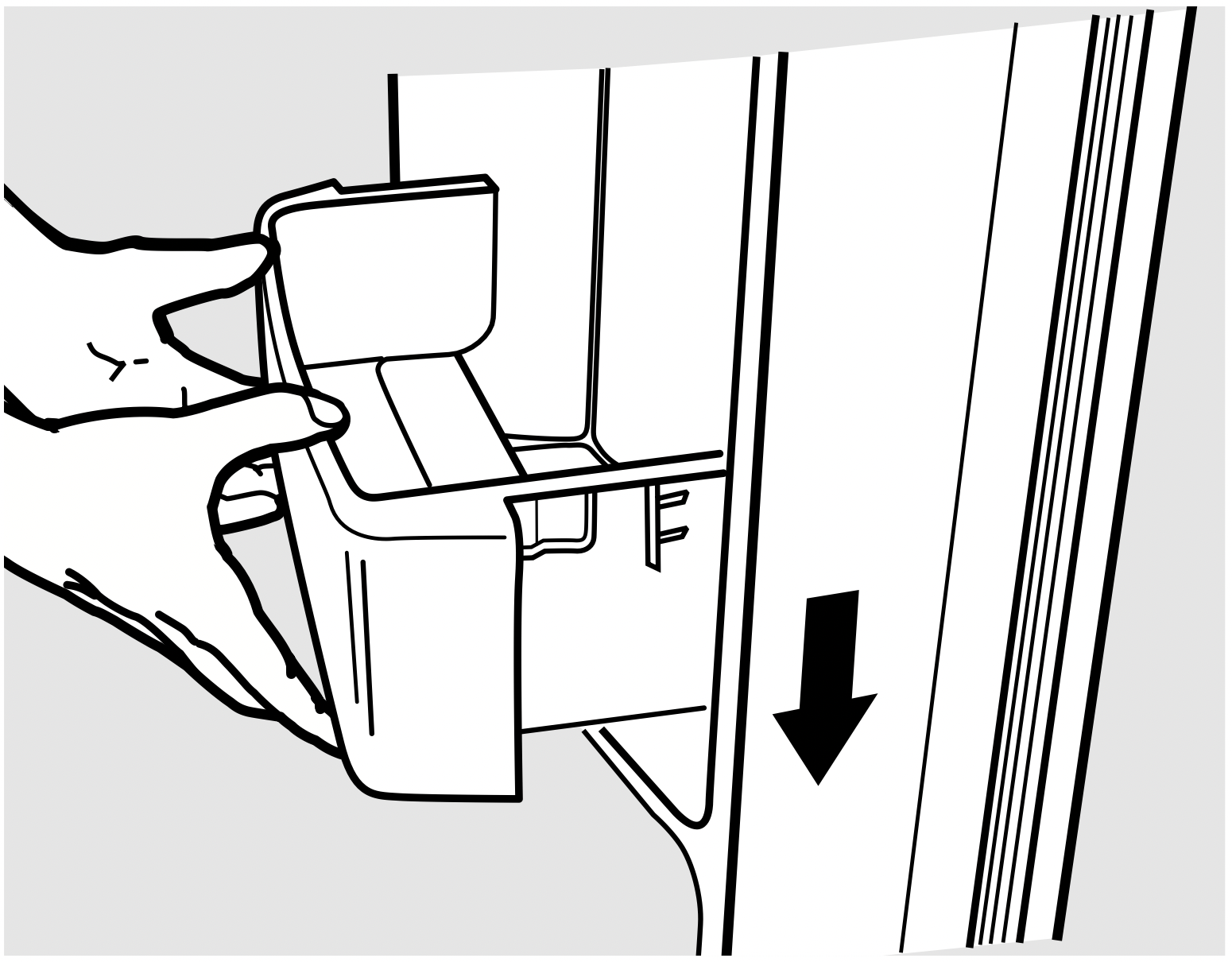
Slide-Out Spillproof Shelf
The slide-out spillproof shelf allows you to reach items stored behind others. The special edges are designed to help prevent spills from dripping to lower shelves.
To remove:
Slide the shelf out until it reaches the stop, then press down on the tab and slide the shelf straight out.
To replace or relocate:
Line the shelf up with the supports and slide it into place. The shelf can be repositioned when the door is at 90°or more. To reposition the shelf, slide the shelf past the stops and angle downward. Slide shelf down to the desired position, line up with the supports and slide into place.
Make sure you push the shelves all the way back in before you close the door.


QuickSpace ™ Shelf
This shelf splits in half and slides under itself for storage of tall items on the shelf below.
This shelf can be removed and replaced or relocated just like Slide-Out Spillproof Shelves.
On some models, this shelf can not be used in the lowest position.
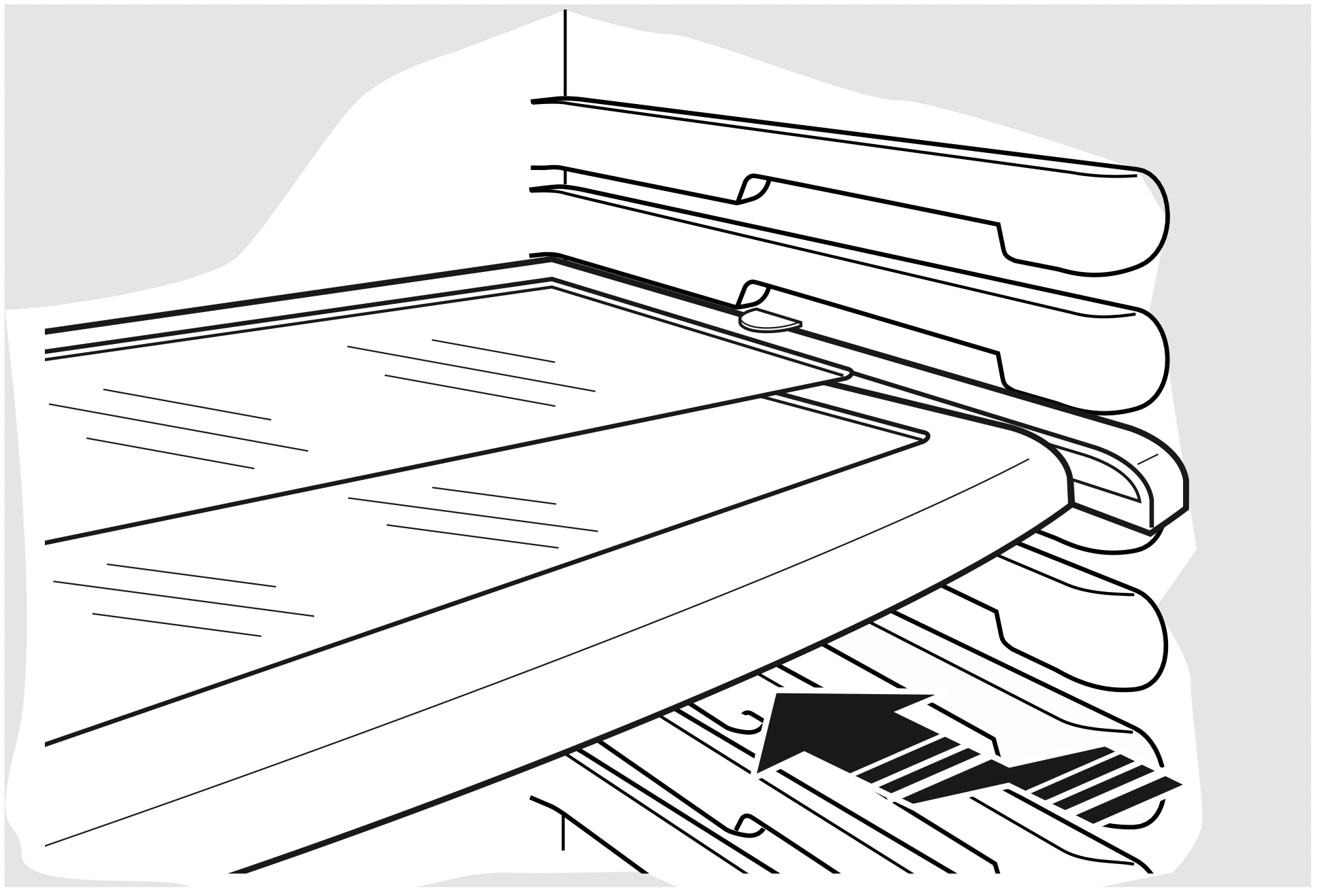
Slide-Out Freezer Shelves
To remove, slide out to the stop position, lift the front past the stop position, and slide out.
Make sure you push the shelves all the way back in before you close the door.
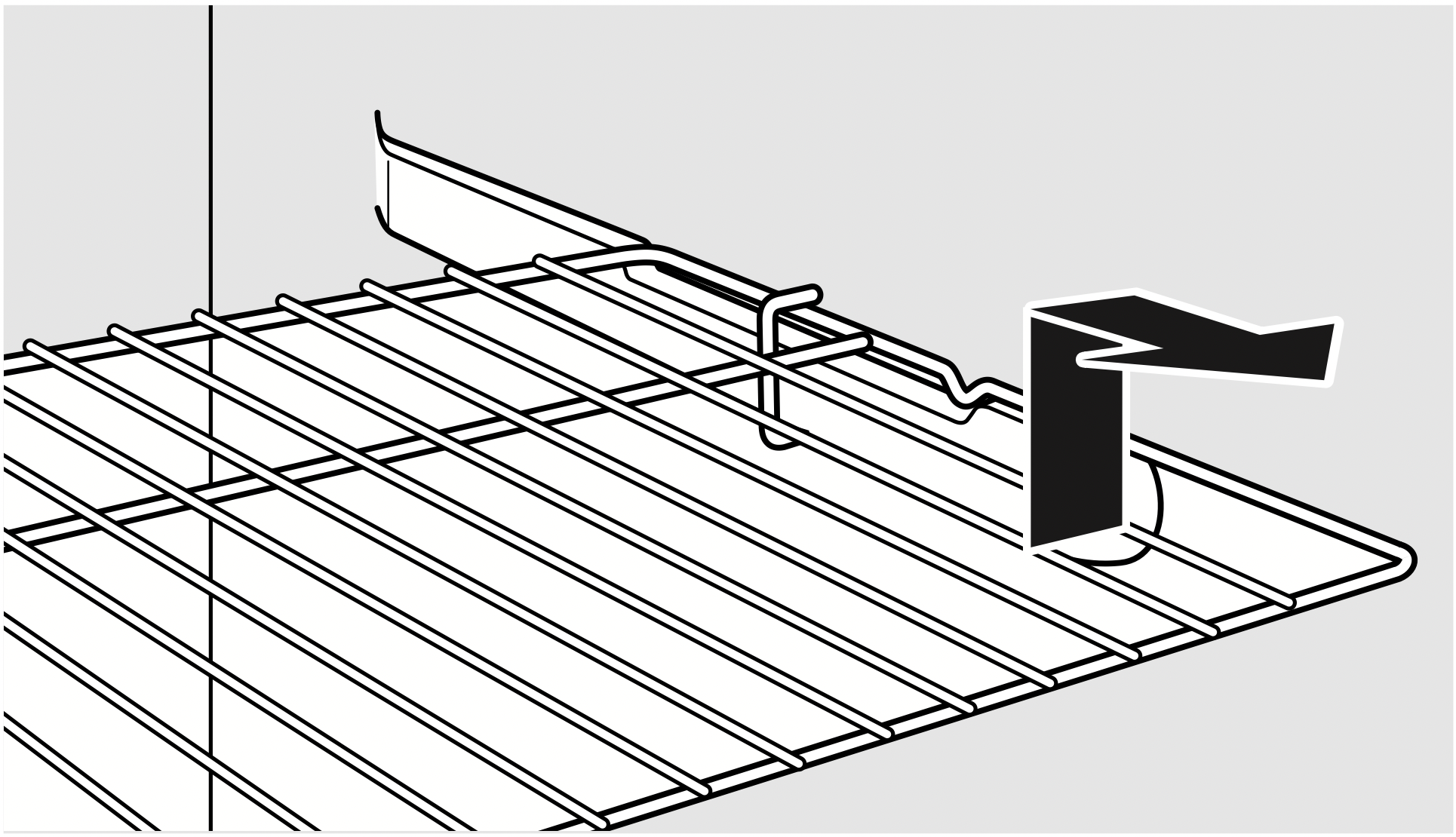
Fixed Freezer Shelves
To remove, lift the shelf up at the left side and then bring the shelf out.
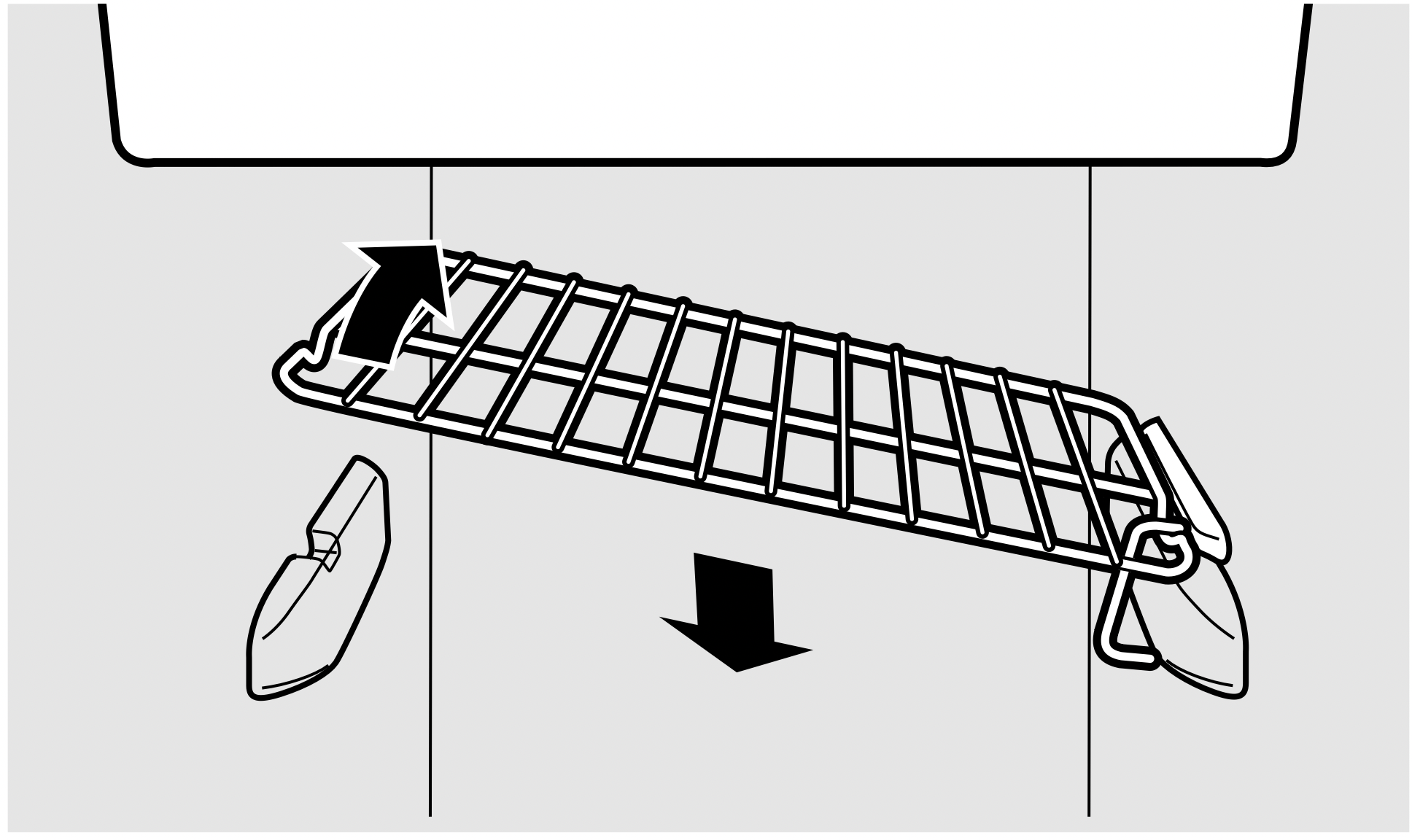
About the additional features.
Not all features are on all models.
ShelfSaver™ Rack
(on some models)
Use this rack to store beverage cans for easy access.
It can also hold a 9″ x 13″ baking dish.
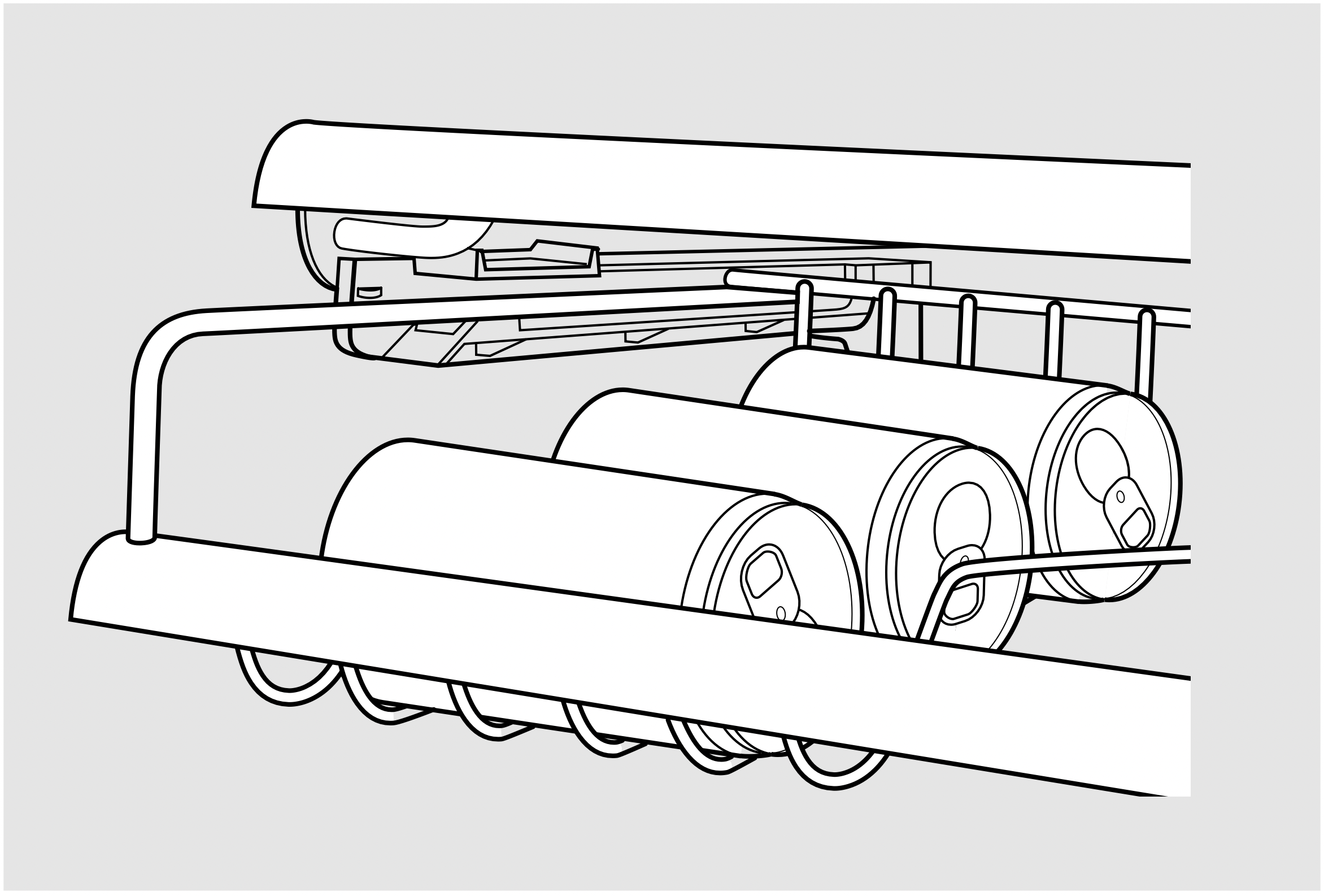
Door Can Rack
(on some models)
This door rack holds up to 9 cans.
NOTE: This rack can only be mounted in the top position under the dairy bin.
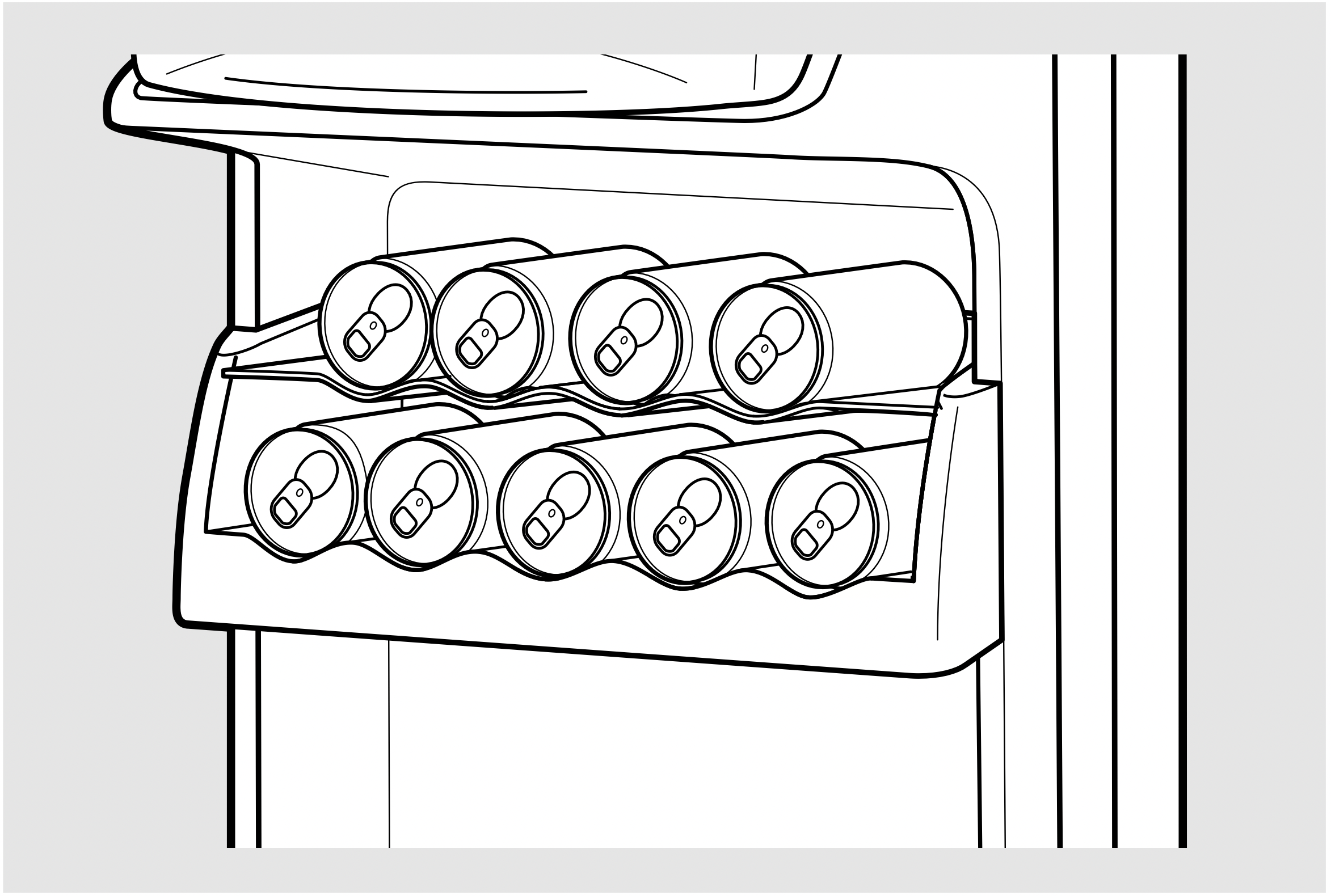
Removable Beverage Rack
The beverage rack is designed to hold a bottle on its side. It can be attached to any slide-out shelf.
To install:
- Line up the large part of the slots on the top of the rack with the tabs under the shelf.
- Then slide the rack back to lock it in place.


About the refrigerator doors.
Refrigerator Doors
The refrigerator doors may feel different than the ones you are used to. The special door opening/closing feature makes sure the doors close all the way and are securely sealed.
When opening and closing the door you will notice a stop position. If the door is opened past this stop point, the door will remain open to allow you to load and unload food more easily. When the door is only partially open, it will automatically close.
The resistance you feel at the stop position will be reduced as the door is loaded with food.
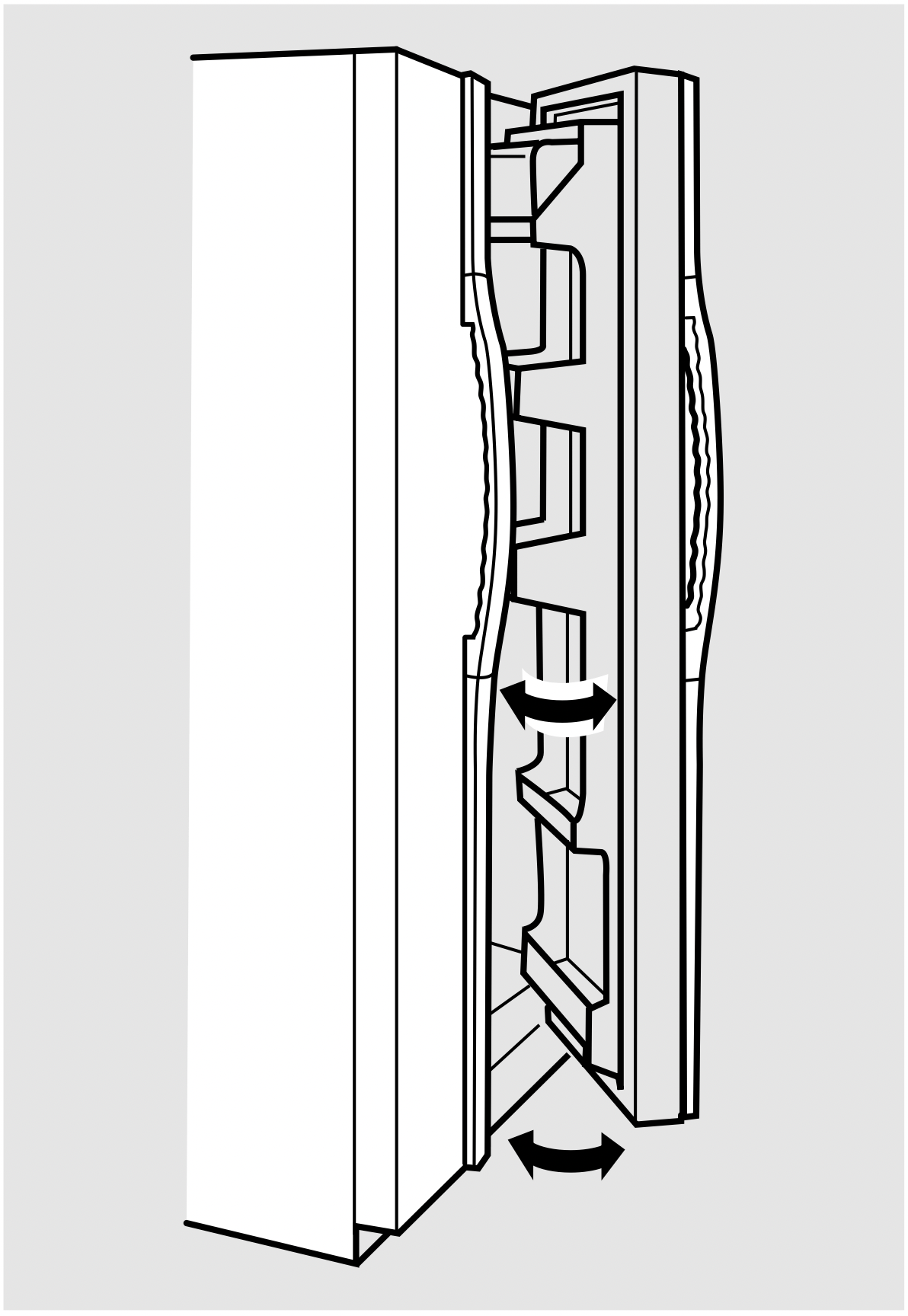
When the door is only partially open, it will automatically close.
Beyond this stop the door will stay open.
Door Alignment
If doors are uneven, adjust the refrigerator door.
- Using a 7/16″ socket wrench, turn the door adjusting screw to the right to raise the door; to the left, to lower it. (A nylon plug, imbedded in the threads of the pin, prevents the pin from turning unless a wrench is used.)
- After one or two turns of the wrench, open and close the refrigerator door and check the alignment at the top of the doors.
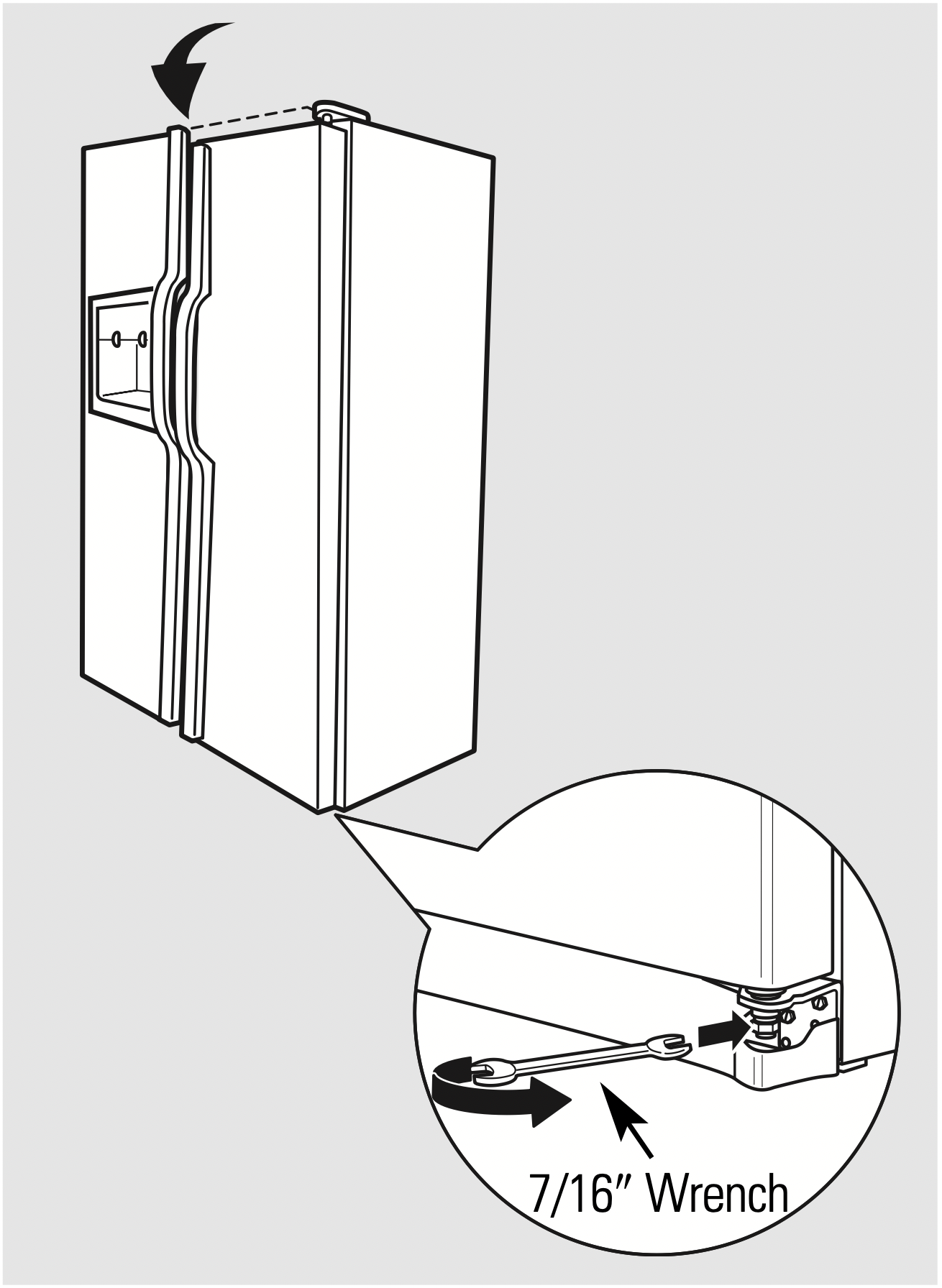
Support Leg
Before moving the refrigerator, you will need to screw up the support leg. Once the unit is relocated, you will need to screw down the support leg again.

About the crispers and pans.
Not all features are on all models.
Fruit and Vegetable Crispers
Excess water that may accumulate in the bottom of the drawers should be wiped dry.
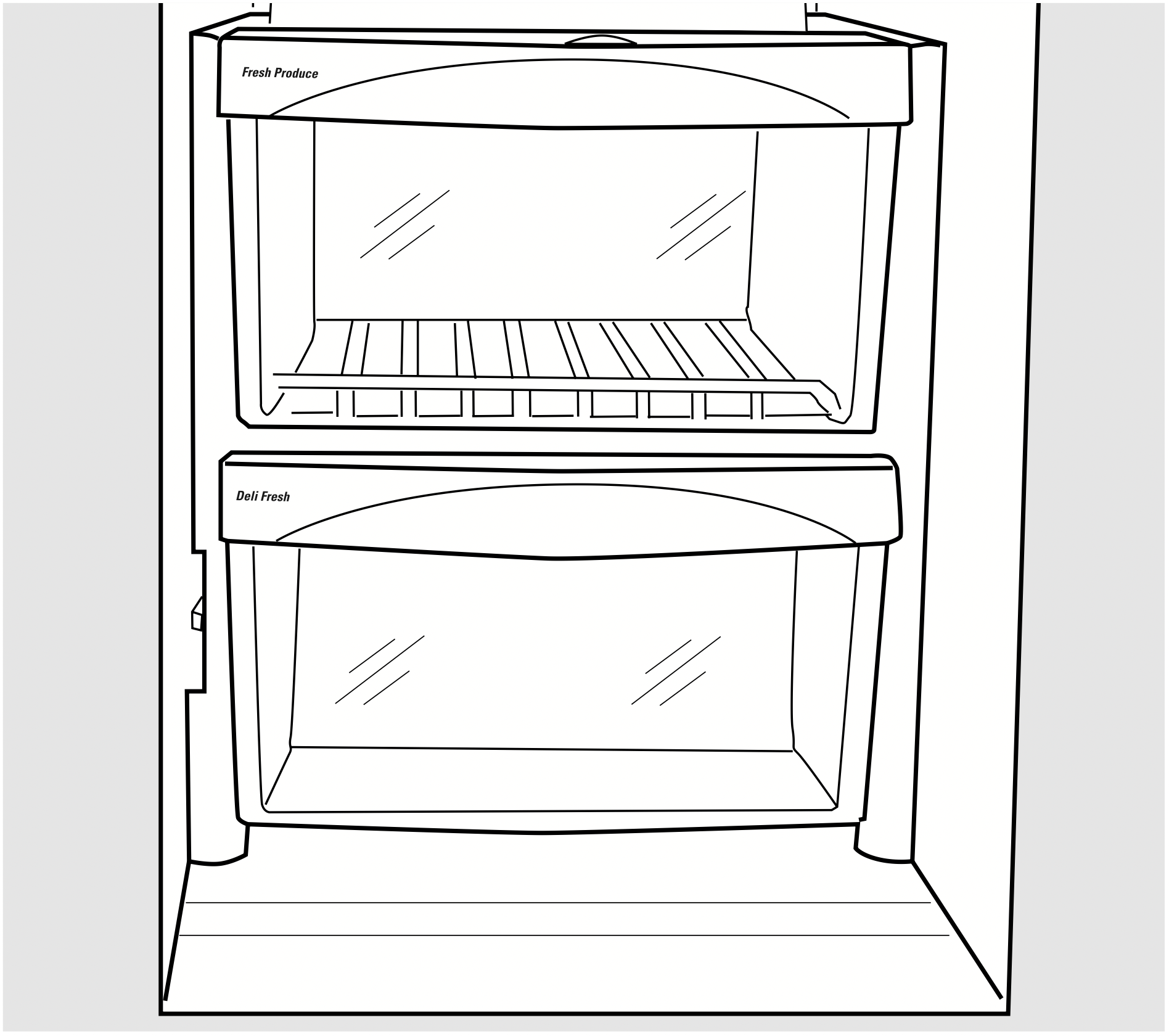
Adjustable Humidity Crispers
Slide the control all the way to the HI setting to provide high humidity recommended for most vegetables.
Slide the control all the way to the LO setting to provide lower humidity levels recommended for most fruits.
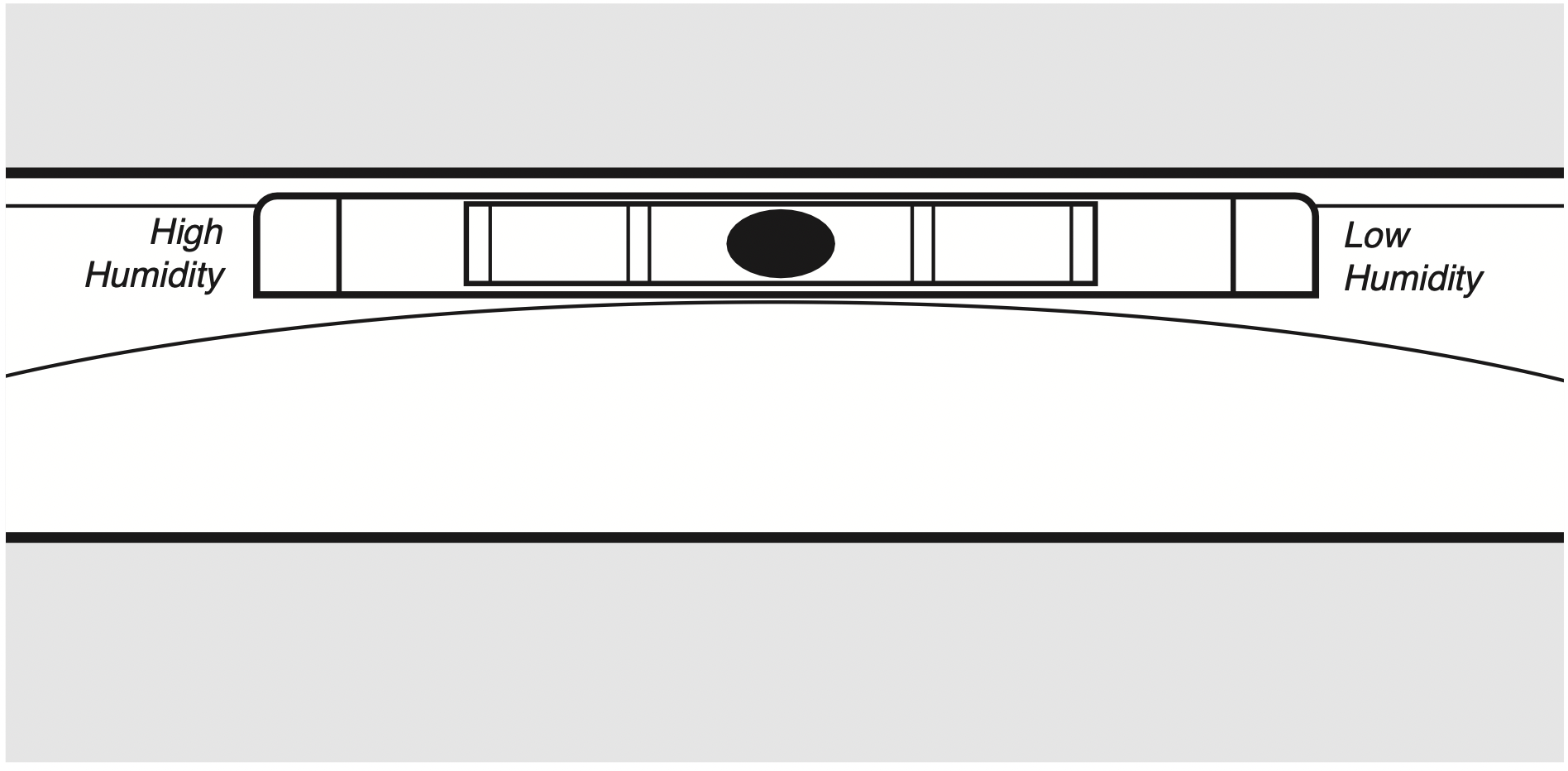
About crisper removal.
Not all features are on all models.
Crisper Removal
Crispers can easily be removed by pulling the drawer straight out and lifting the drawer up and over the stop location.
If the door prevents you from taking out the drawers, first try to remove the door bins. If this does not offer enough clearance, the refrigerator will need to be rolled forward until the door opens enough to slide the drawers out. In some cases, when you roll the refrigerator out, you will need to move the refrigerator to the left or right as you roll it out.
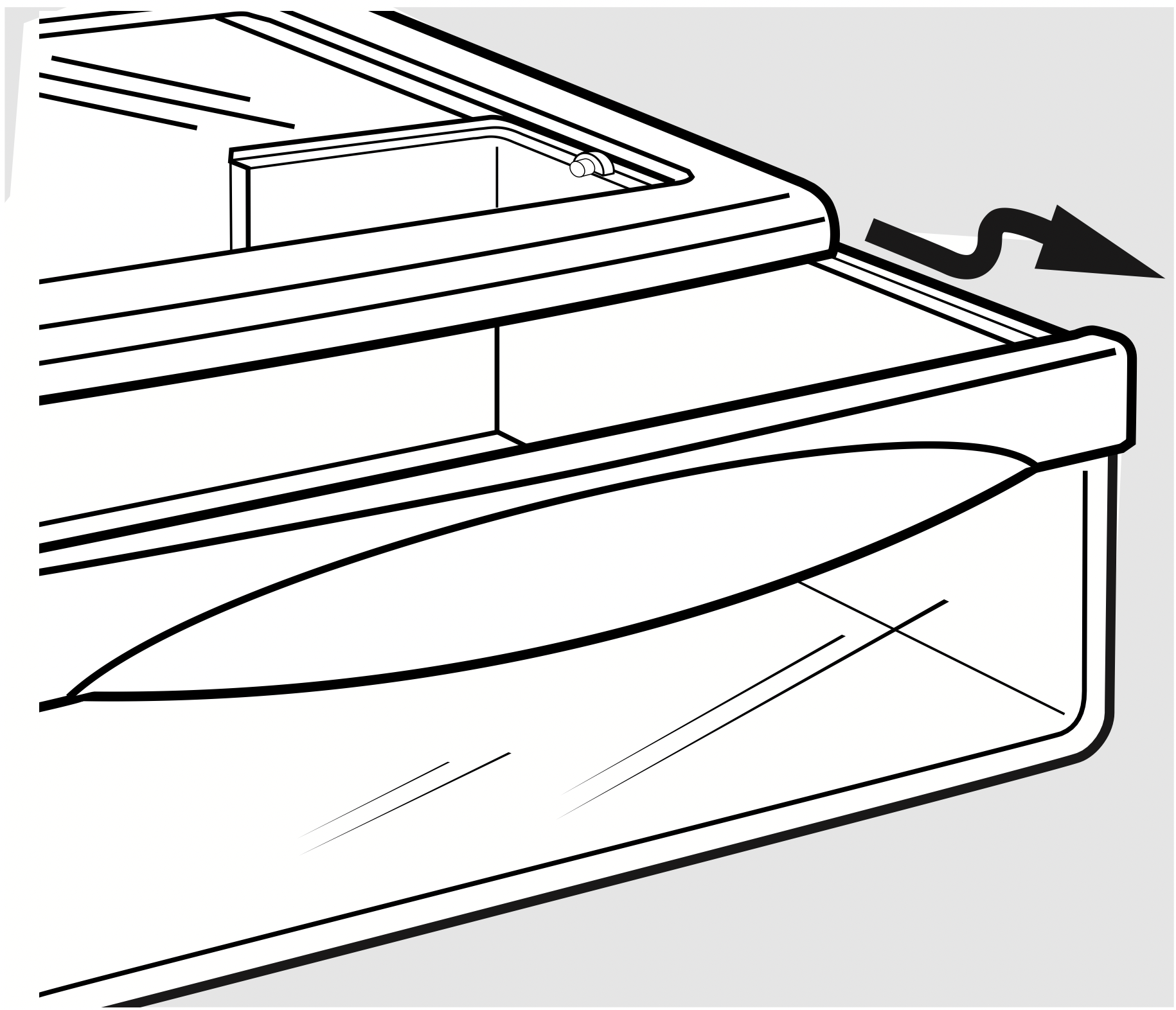
About the automatic icemaker.
A newly-installed refrigerator may take 12 to 24 hours to begin making ice.
Automatic Icemaker
The icemaker will produce seven cubes per cycle—approximately 100–130 cubes in a 24-hour period, depending on freezer compartment temperature, room temperature, number of door openings and other use conditions.
If the refrigerator is operated before the water connection is made to the icemaker, set the power switch in the OFF position.
When the refrigerator has been connected to the water supply, set the power switch to the ON position.
The icemaker will fill with water when it cools to 15°F (–10°C). A newly-installed refrigerator may take 12 to 24 hours to begin making ice cubes.
Throw away the first few batches of ice to allow the water line to clear.
Be sure nothing interferes with the sweep of the feeler arm.
When the bin fills to the level of the feeler arm, the icemaker will stop producing ice.
It is normal for several cubes to be joined together.
If ice is not used frequently, old ice cubes will become cloudy, taste stale and shrink.

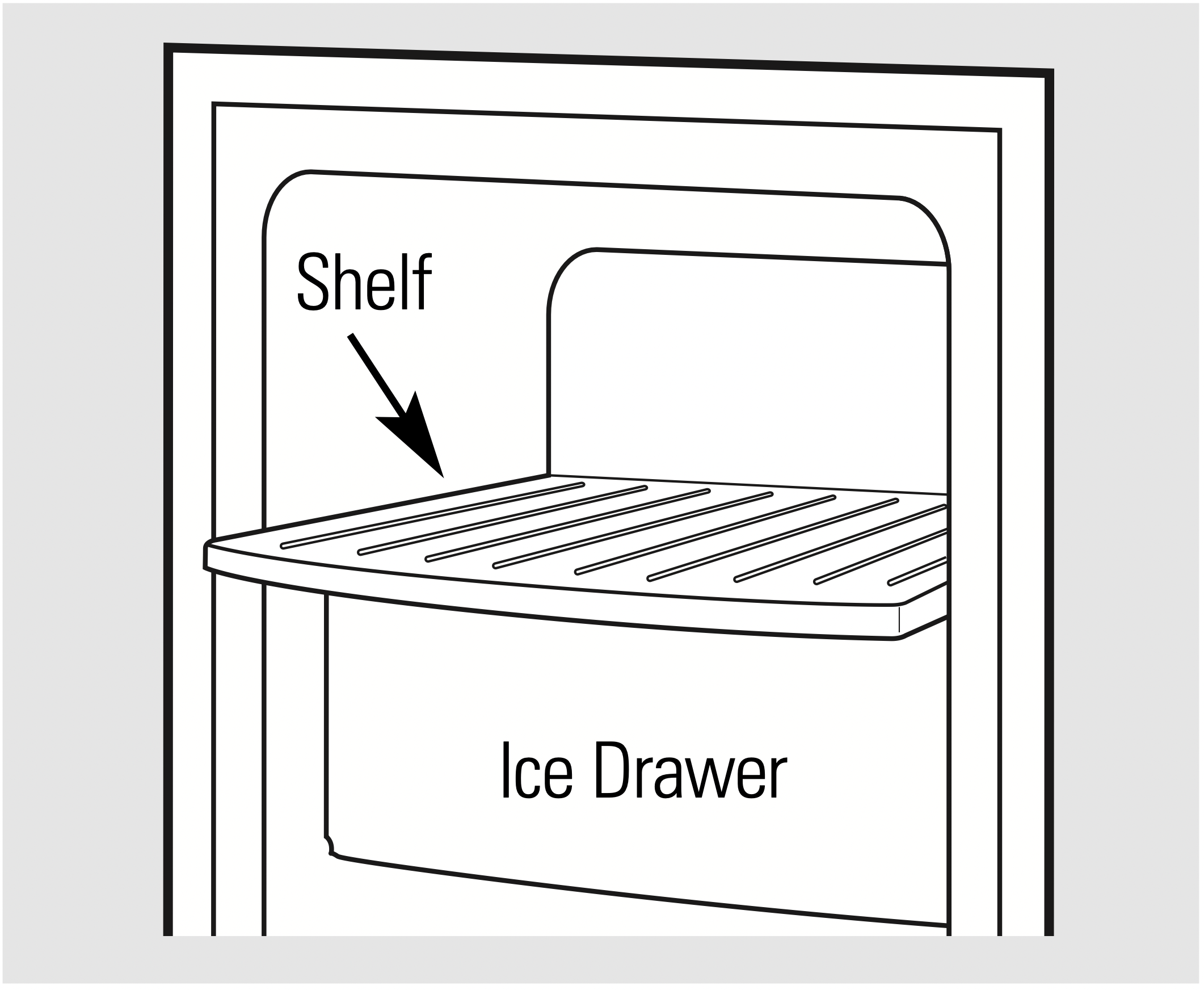
Pull the upper freezer shelf straight out to access the icemaker. Always be sure to replace the shelf. The shelf can be used for storage.
Ice Storage Drawer
To access ice, pull the drawer forward.
To remove the drawer, pull it straight out and lift it past the stop location.
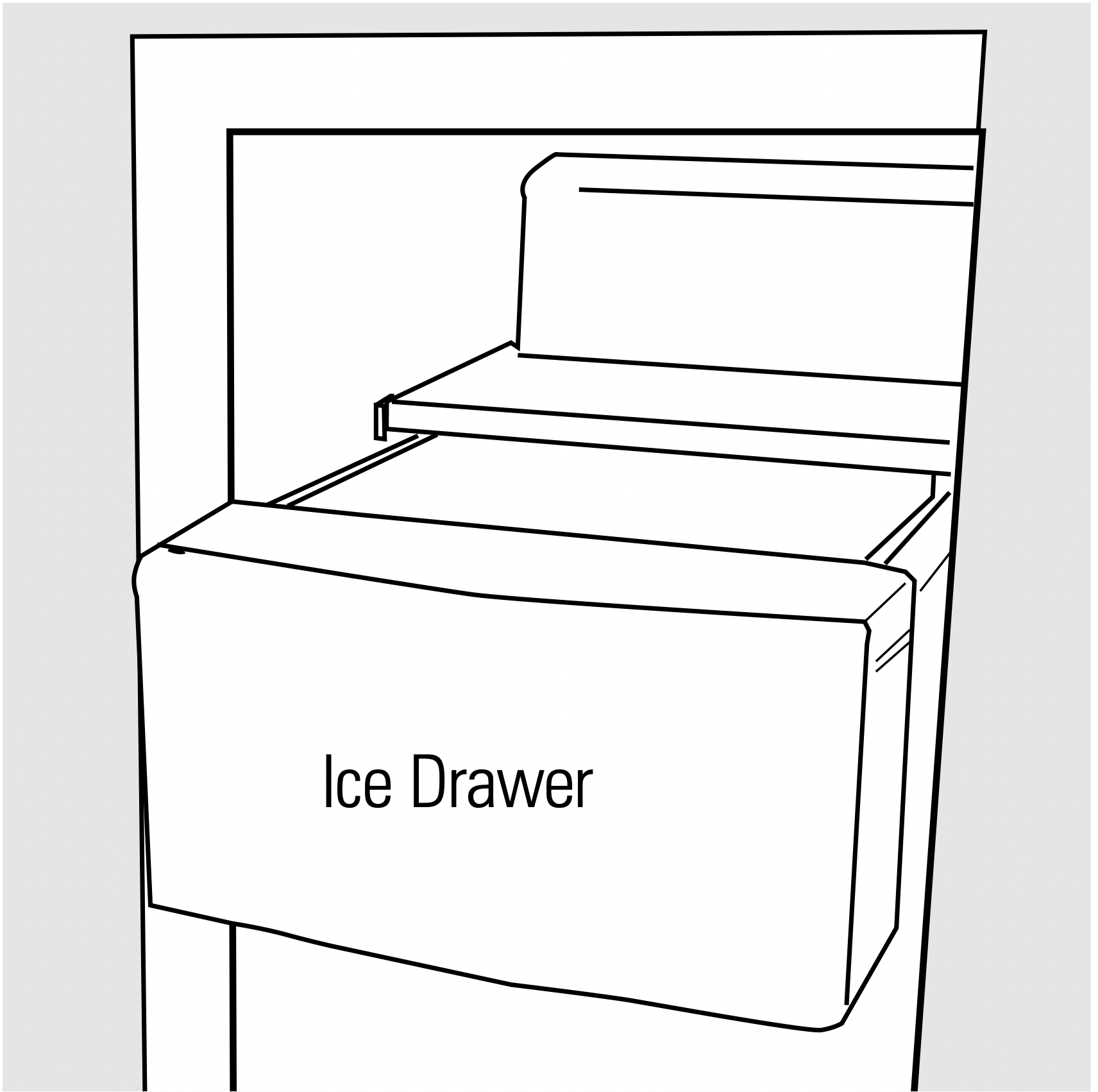
About the ice and water dispenser.
On some models
To Use the Dispenser
Select CUBED ICE  , CRUSHED ICE
, CRUSHED ICE  or WATER
or WATER  .
.
Press the glass gently against the top of the dispenser cradle.
The spill shelf is not self-draining.
To reduce water spotting, the shelf and its grille should be cleaned regularly.
If no water is dispensed when the refrigerator is first installed, there may be air in the water line system. Press the dispenser arm for at least two minutes to remove trapped air from the water line and to fill the water system. To flush out impurities in the water line, throw away the first six glassfuls of water.
CAUTION: Never put fingers or any other objects into the ice crusher discharge opening.
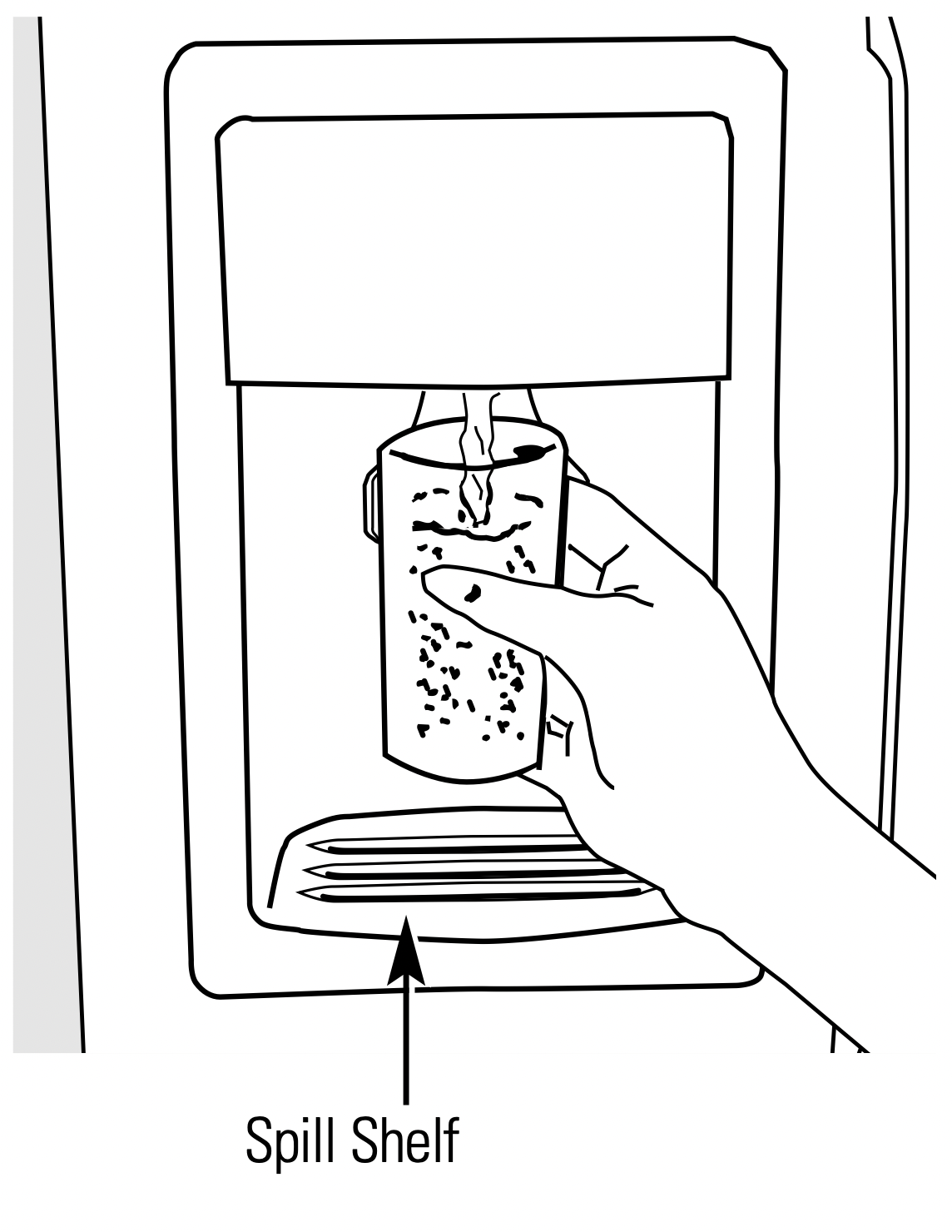
Locking the Dispenser
Press the LOCK pad for 3 seconds to lock the dispenser and control panel.
To unlock, press and hold the pad again for 3 seconds.

Dispenser Light
This pad turns the night light in the dispenser on and off. The light also comes on when the dispenser cradle is pressed. If this light burns out, it should be replaced with a 6 watt 12 V maximum bulb.

Quick Ice (on some models)
When you need ice in a hurry, press this pad to speed up ice production. This will increase ice production for the following 48 hours or until you press the pad again.
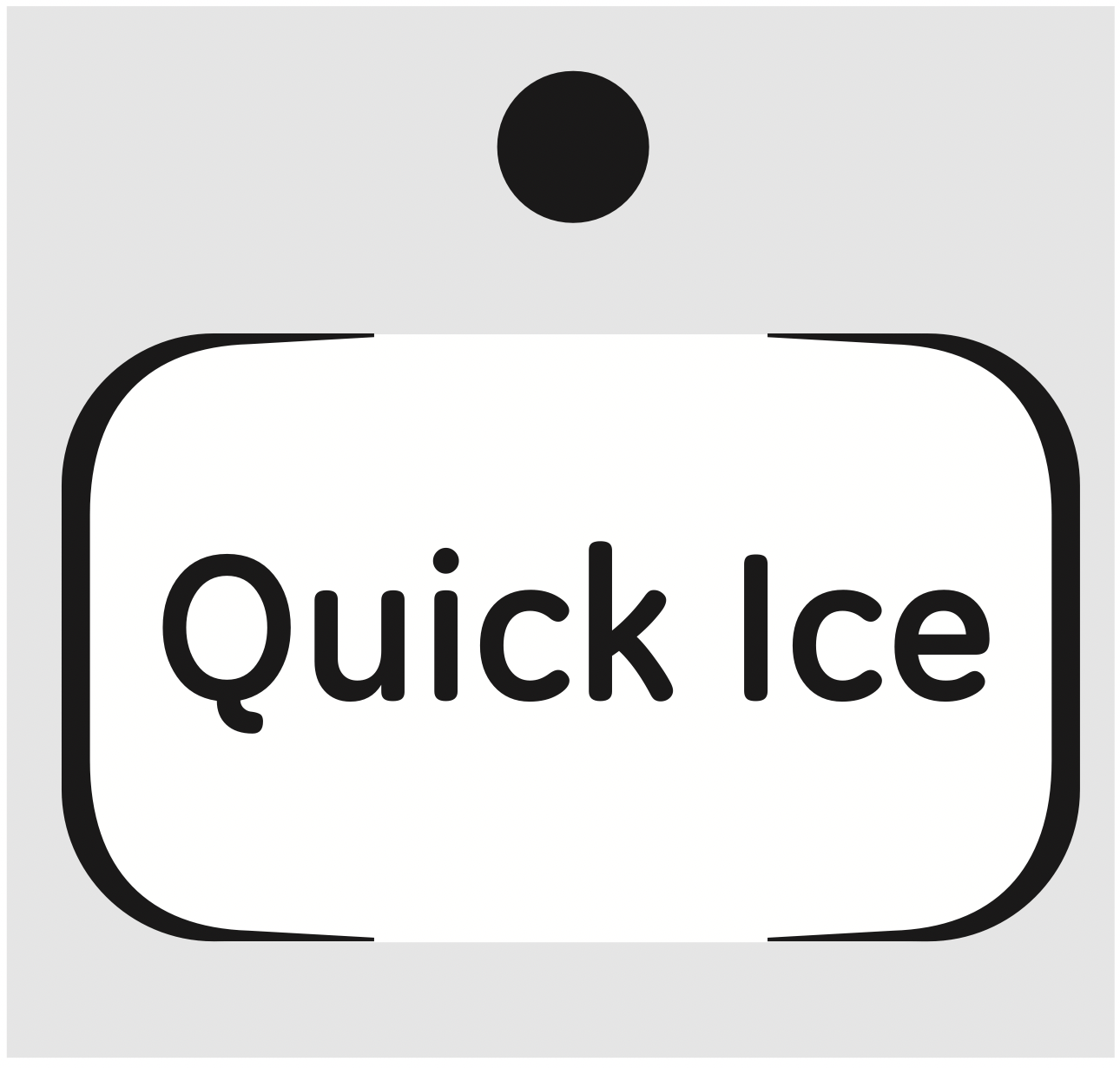
Door Alarm (on some models)
To set the alarm, press this pad until the indicator light comes on. This alarm will sound if either door is open for more than 3 minutes. The light goes out and the beeping stops when you close the door.

Important Facts About Your Dispenser
- Do not add ice from trays or bags to the storage drawer. It may not crush or dispense well.
- Avoid overfilling glass with ice and use of narrow glasses. Backed-up ice can jam the chute or cause the door in the chute to freeze shut. If ice is blocking the chute, poke it through with a wooden spoon.
- Beverages and foods should not be quick-chilled in the ice storage drawer. Cans, bottles or food packages in the storage drawer may cause the icemaker or auger to jam.
- To keep dispensed ice from missing the glass, put the glass close to, but not touching, the dispenser opening.
- Some crushed ice may be dispensed even though you selected CUBED ICE. This happens occasionally when a few cubes accidentally get directed to the crusher.
- After crushed ice is dispensed, some water may drip from the chute.
- Sometimes a small mound of snow will form on the door in the ice chute. This condition is normal and usually occurs when you have dispensed crushed ice repeatedly. The snow will eventually evaporate.
About the ice and water dispenser.
Ice Storage Drawer on Dispenser Models
To remove:
Set the icemaker power switch to the OFF position. Pull the drawer straight out and then lift past the stop position.
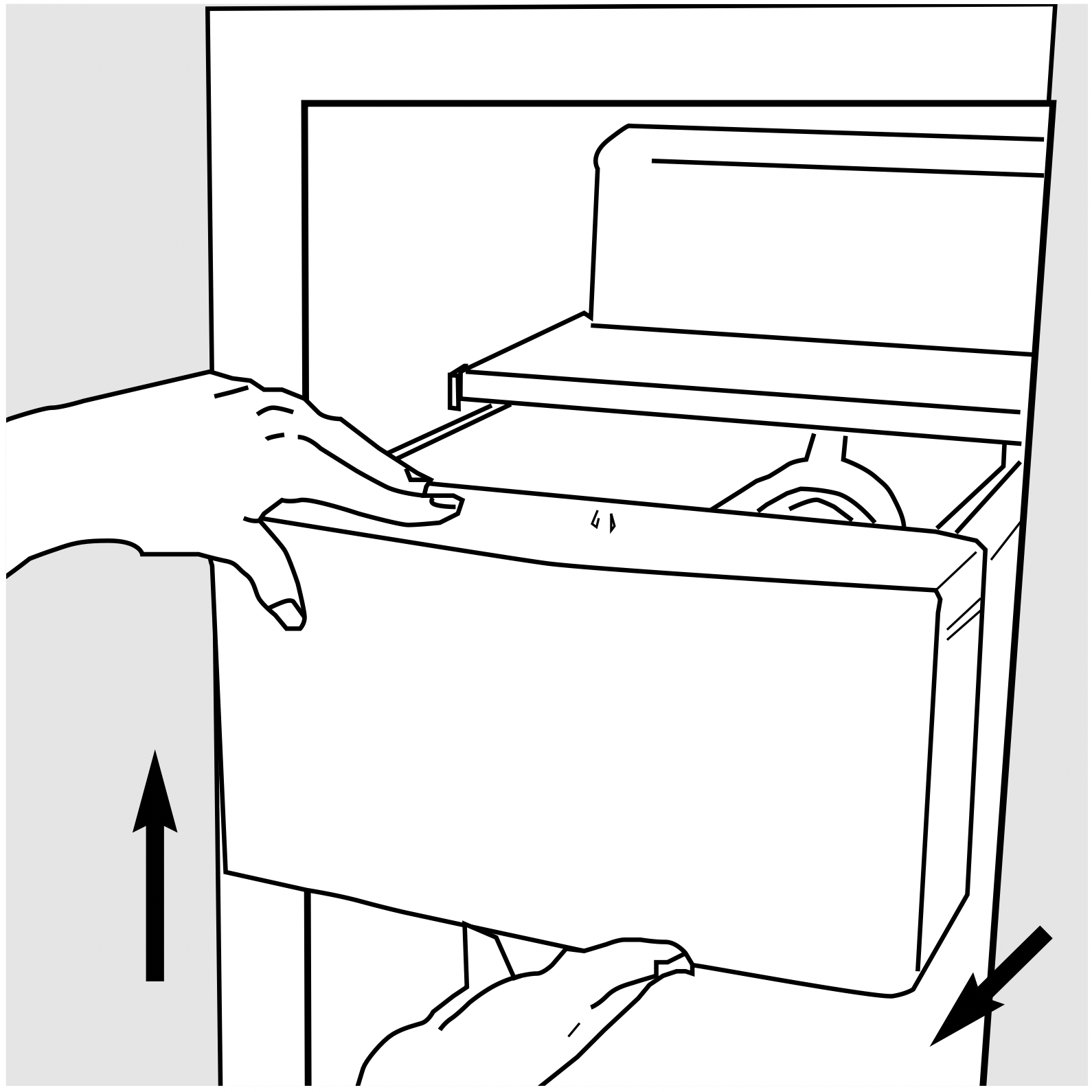
To replace:
When replacing the drawer, be sure to press it firmly into place. If it does not go all the way back, remove it and rotate the drive mechanism 1/4 turn. Then push the drawer back again.

Care and Cleaning
Cleaning the Outside
The dispenser drip area, (on some models) beneath the grille, should be wiped dry. Water left in this area may leave deposits. Remove the deposits by adding undiluted vinegar to the well. Soak until the deposits disappear or become loose enough to rinse away.
The dispenser cradle (on some models). Before cleaning, lock the dispenser by pressing and holding the LOCK pad for 3 seconds. Clean with warm water and baking soda solution—about a tablespoon (15 ml) of baking soda to a quart (1 liter) of water. Rinse thoroughly and wipe dry.
The door handles and trim. Clean with a cloth dampened with soapy water. Dry with a soft cloth.
The stainless steel panels and door handles (on some models) can be cleaned with a commercially available stainless steel cleaner such as Stainless Steel Magic.™
Stainless Steel Magic is available at Ace, True Value, Servistar, HWI and other leading stores. It is also available through GE Parts and Accessories, 800.626.2002. Order part number WX10X15.
Do not use appliance wax or polish on the stainless steel.
Keep the outside clean. Wipe with a clean cloth lightly dampened with kitchen appliance wax or mild liquid dish detergent. Dry and polish with a clean, soft cloth.
Do not wipe the refrigerator with a soiled dish cloth or wet towel. These may leave a residue that can erode the paint. Do not use scouring pads, powdered cleaners, bleach or cleaners containing bleach because these products can scratch and weaken the paint finish.
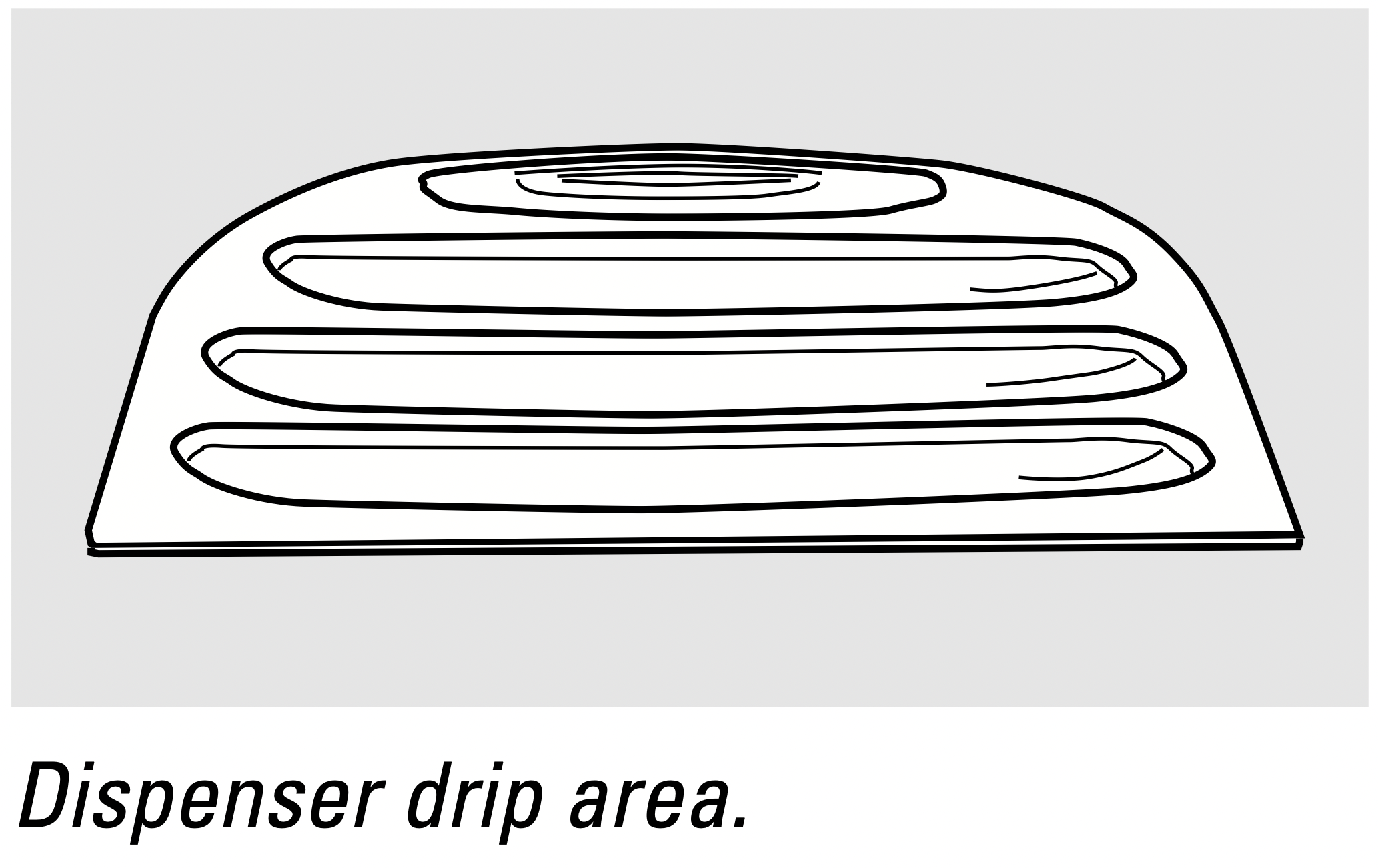
Cleaning the Inside
To help prevent odors, leave an open box of baking soda in the fresh food and freezer compartments.
Unplug the refrigerator before cleaning. If this is not practical, wring excess moisture out of sponge or cloth when cleaning around switches, lights or controls.
Use warm water and baking soda solutionabout a tablespoon (15 ml) of baking soda to a quart (1 liter) of water. This both cleans and neutralizes odors. Rinse and wipe dry.
Use of any cleaning solution other than that which is recommended, especially those that contain petroleum distillates, can crack or damage the interior of the refrigerator.
Avoid cleaning cold glass shelves with hot water because the extreme temperature difference may cause them to break. Handle glass shelves carefully. Bumping tempered glass can cause it to shatter.
Do not wash any plastic refrigerator parts in the dishwasher.
Behind the Refrigerator
Be careful when moving the refrigerator away from the wall. All types of floor coverings can be damaged, particularly cushioned coverings and those with embossed surfaces.
Pull the refrigerator straight out and return it to position by pushing it straight in. Moving the refrigerator in a side direction may result in damage to the floor covering or refrigerator.
When pushing the refrigerator back, make sure you don’t roll over the power cord or icemaker supply line (on some models).
Preparing for Vacation
For long vacations or absences, remove food and unplug the refrigerator. Clean the interior with a baking soda solution of one tablespoon (15 ml) of baking soda to one quart (1 liter) of water. Leave the doors open.
Set the icemaker power switch to the OFF position and shut off the water supply to the refrigerator.
If the temperature can drop below freezing, have a qualified servicer drain the water supply system (on some models) to prevent serious property damage due to flooding.
Preparing to Move
Secure all loose items such as shelves and drawers by taping them securely in place to prevent damage.
When using a hand truck to move the refrigerator, do not rest the front or back of the refrigerator against the hand truck. This could damage the refrigerator. Handle only from the sides of the refrigerator.
Be sure the refrigerator stays in an upright position during moving.
Replacing the light bulbs.
Setting either or both controls to 0 does not remove power to the light circuit.
Refrigerator Compartment—Upper Light
- Unplug the refrigerator.
- The bulb is located at the top of the compartment, inside the dome light shield. To remove the shield, place your finger in the pocket at the back of the shield. Pull the shield forward and down.
- After replacing the bulb with an appliance bulb of the same or lower wattage, replace the light shield.
- Plug the refrigerator back in.
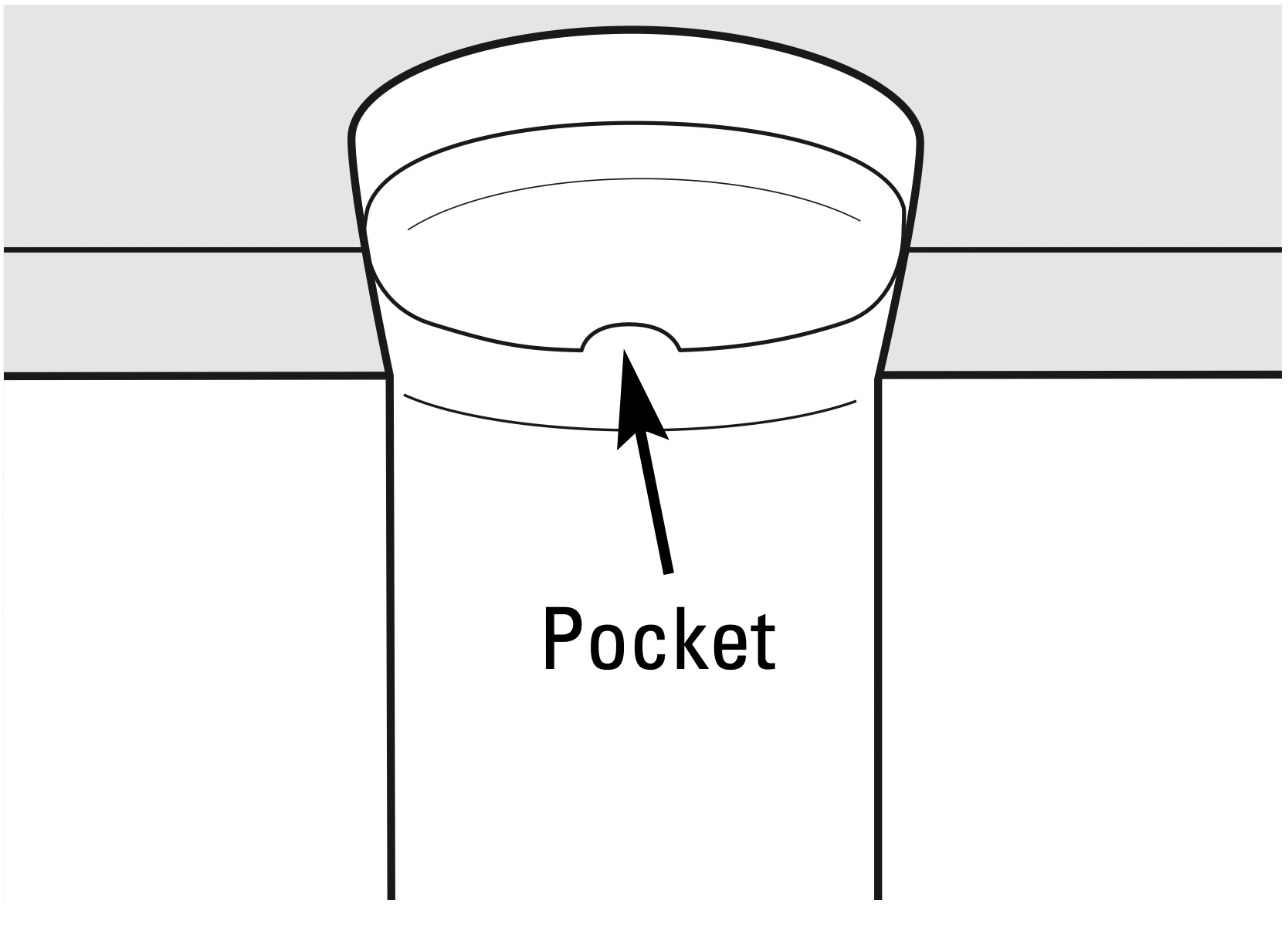
Refrigerator Compartment—Lower Light
This light is located above the top drawer.
- Unplug the refrigerator.
- Lift the light shield up and pull it out.
- After replacing the bulb with an appliance bulb of the same or lower wattage, replace the shield.
- Plug the refrigerator back in.
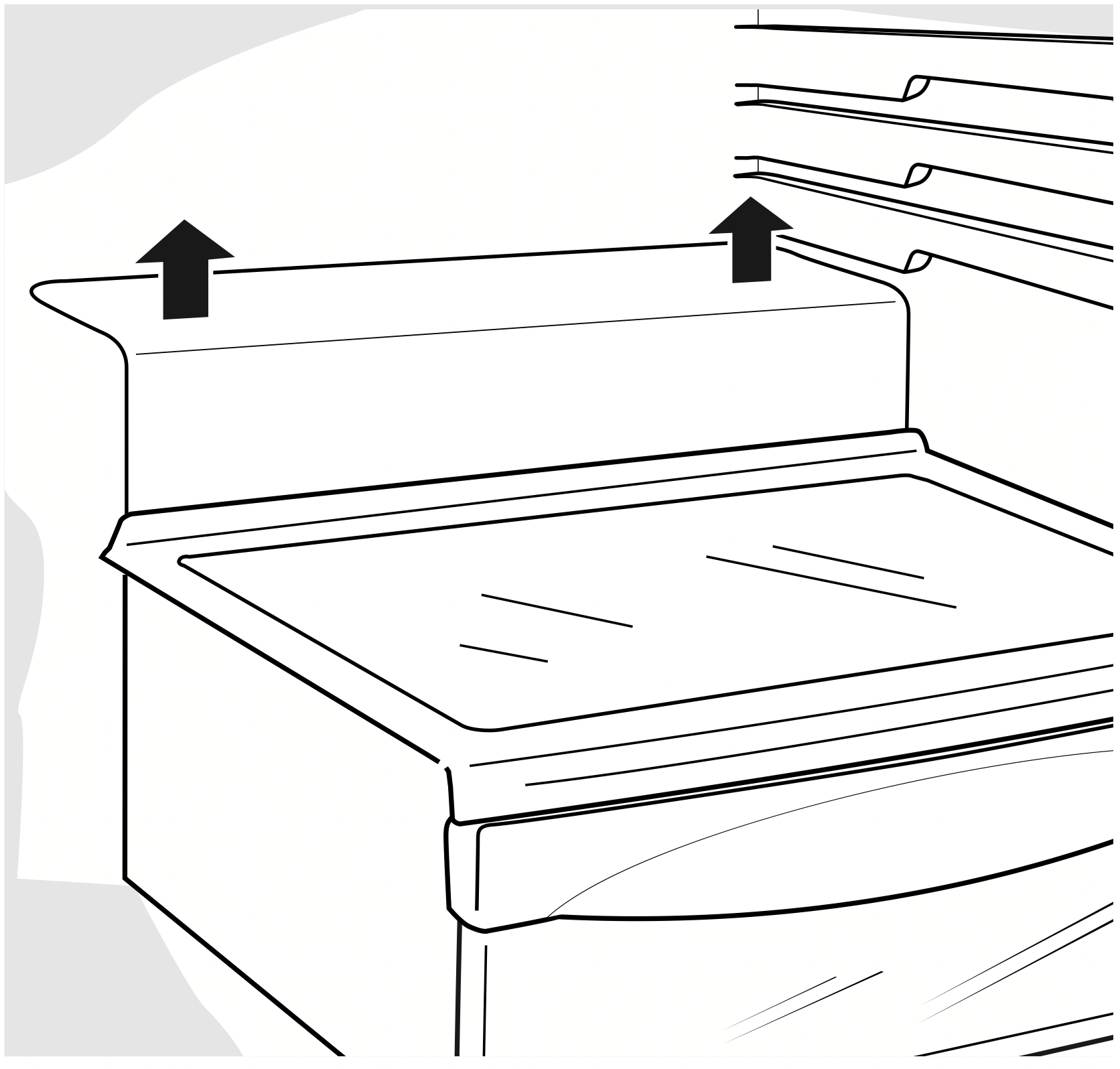
Freezer Compartment
- Unplug the refrigerator.
- Remove the shelf just above the light shield. (The shelf will be easier to remove if it is emptied first.) On some models, a screw at the top of the light shield will need to be removed.
- To remove the light shield, press in on the sides, and lift up and out. On some models, lift the light shield up and pull it out.
- Replace the bulb with an appliance bulb of the same or lower wattage, and reinstall the light shield. When reinstalling the light shield, make sure the top tabs snap securely into place. Replace the screw (on some models).
- Reinstall the shelf and plug the refrigerator back in.
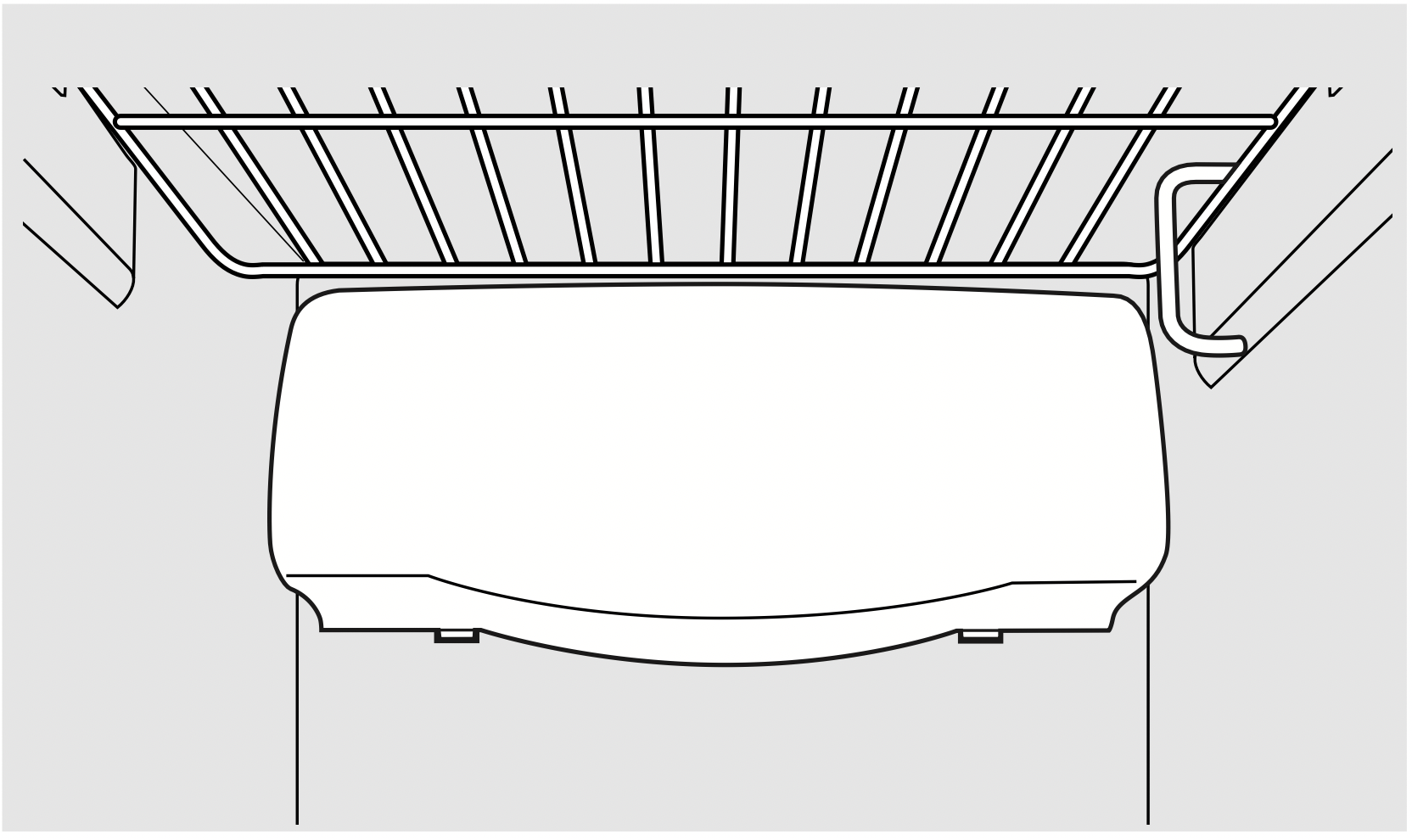
Dispenser
- Unplug the refrigerator.
- The bulb is located on the dispenser under the control panel. Remove the light bulb by turning it counterclockwise.
- Replace the bulb with a bulb of the same size and wattage.
- Plug the refrigerator back in.
Troubleshooting
| Problem | Possible Causes | What To Do |
|---|---|---|
| Refrigerator does not operate | Refrigerator in defrost cycle. |
|
| Either or both controls set to OFF. |
|
|
| Refrigerator is unplugged. |
|
|
| The fuse is blown/circuit breaker is tripped. |
|
|
| Refrigerator is in the showroom mode. |
|
|
| Vibration or rattling (slight vibration is normal) |
Rollers need adjusting. |
|
| Motor operates for long periods or cycles on and off frequently. (Modern refrigerators with more storage space and a larger freezer require more operating time. They start and stop often to maintain even temperatures.) | Normal when refrigerator is first plugged in. |
|
|
Often occurs when large amounts of food are placed in refrigerator. |
|
|
| Door left open. |
|
|
| Hot weather or frequent door openings. |
|
|
| Temperature controls set at the coldest setting. |
|
|
| Refrigerator or freezer compartment too warm |
Temperature control not set cold enough. |
|
|
Warm weather or frequent door openings. |
|
|
|
Door left open. |
|
|
|
Frost or ice crystals on frozen food (frost within package is normal) |
Door left open. |
|
|
Too frequent or too long door openings. |
||
| Divider between refrigerator and freezer compartments feels warm | Automatic energy saver system circulates warm liquid around front edge of freezer compartment. |
|
| Automatic icemaker does not work | Icemaker power switch is in the OFF position. |
|
|
Water supply turned off or not connected. |
|
|
| Freezer compartment too warm. |
|
|
|
Piled up cubes in the storage bin cause the icemaker to shut off. |
|
|
| Ice cubes stuck in icemaker. |
|
|
| Ice cubes have odor/taste | Ice storage bin needs cleaning. |
|
|
Food transmitting odor/taste to ice cubes. |
|
|
| Interior of refrigerator needs cleaning. |
|
|
| Small or hollow cubes |
Water filter clogged. |
|
| Slow ice cube freezing | Door left open. |
|
| Temperature control not set cold enough. |
|
|
|
Orange glow in the freezer |
Defrost heater is on. |
|
| Cube dispenser does not work (on some models) | Icemaker turned off or water supply turned off. |
|
| Ice cubes are frozen to icemaker feeler arm. |
|
|
| Irregular ice clumps in storage container. |
|
|
| Dispenser is LOCKED. |
|
|
| Water has poor taste/odor (on some models) |
Water dispenser has not been used for a long time. |
|
|
Water in first glass is warm (on some models) |
Normal when refrigerator is first installed. |
|
|
Water dispenser has not been used for a long time. |
|
|
|
Water system has been drained. |
|
|
| Water dispenser does not work (on some models) |
Water supply line turned off or not connected. |
|
| Water filter clogged. |
|
|
| Air may be trapped in the water system. |
|
|
| Dispenser is LOCKED. |
|
|
|
Water spurting from dispenser (on some models) |
Newly-installed filter cartridge. |
|
| Water is not dispensed (on some models) but icemaker is working | Water in reservoir is frozen. |
|
| Refrigerator control setting is too cold. |
|
|
|
No water or ice cube production. |
Supply line or shutoff valve is clogged. |
|
| Water filter clogged. |
|
|
| Dispenser is LOCKED. |
|
|
|
CUBED ICE was selected but CRUSHED ICE was dispensed (on some models) |
Last setting was CRUSHED ICE. |
|
| Refrigerator has odor | Foods transmitting odor to refrigerator. |
|
|
Interior needs cleaning. |
|
|
|
Moisture forms on outside of refrigerator |
Not unusual during periods of high humidity. |
|
|
Moisture collects inside (in humid weather, air carries moisture into refrigerator when doors are opened) |
Too frequent or too long door openings | |
| Interior light does not work |
No power at outlet. |
|
| Light bulb burned out. |
|
|
|
Water on kitchen floor or on bottom of freezer |
Cubes jammed in chute. |
|
| Hot air from bottom of refrigerator |
Normal air flow cooling motor. In the refrigeration process, it is normal that heat be expelled in the area under the refrigerator. Some floor coverings are sensitive and will discolor at these normal and safe temperatures. |
|
|
Refrigerator never shuts off but the temperatures are OK |
Adaptive defrost keeps compressor running during door openings. |
|
| Refrigerator is beeping |
Door is open. |
|
| Door not closing properly | Door gasket on hinge side sticking or folding over. |
|
|
A door bin is hitting a shelf inside the refrigerator. |
|
|
| Actual temperature not equal to Set temperature | Unit just plugged in. |
|
| Door open for too long. |
|
|
| Warm food added to refrigerator. |
|
|
| Defrost cycle is in process. |
|
